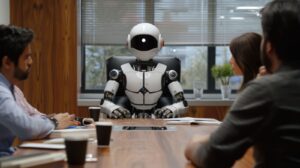
Introduction: The Paradox of Progress
When companies bring in automation and AI, it often looks like a big step in the future. It comes with a promise that it might replace human resources as machines can work faster, cost less, and never get tired. Leaders talk about efficiency, and investors see higher profits. On the surface, it feels like success. But the reality is very different: AI may replace jobs, but it doesn’t take responsibility. People who lose their roles face uncertainty, and those who stay behind are often left with more work and little support.
The Illusion of “Efficiency”
Layoffs linked to automation are often packaged under the umbrella of “efficiency” or “strategic restructuring.” The logic goes: if AI can handle repetitive processes, fewer people are needed. But efficiency is not the same as responsibility. While headcounts shrink, the actual workload rarely disappears—it mutates. AI systems may automate emails, summarize calls, or process data, but when something goes wrong—when bias creeps in, when errors slip through, when context is lost—humans are still expected to step in.
The problem? There are now fewer humans left to catch those failures.
Workload Piling On
A recurring story from employees across industries is that after layoffs, their job didn’t vanish—it multiplied. Marketing associates suddenly become “AI supervisors” while still being expected to deliver campaigns. Analysts now “audit” machine outputs alongside their original reporting tasks. Customer support teams must handle escalations the bot couldn’t solve, often under stricter time limits.
Automation promised relief, but in reality, it has created a new layer of invisible labor: the work of monitoring, correcting, and making sense of machines.
Responsibility Without Accountability
Here’s the irony: AI doesn’t take responsibility when things go wrong. A chatbot cannot apologize for insensitive responses in a way that rebuilds trust. A predictive system cannot justify a flawed layoff decision to a regulator. That responsibility falls squarely back on humans—often the very ones who were sidelined or stretched thin by automation in the first place.
What emerges is a responsibility vacuum: work is reduced to transactions handled by machines, while accountability for consequences is left dangling in human hands.
The Human Cost
The impact is twofold:
- For laid-off employees: skills and loyalty are discounted as cost centers, creating disillusionment and instability.
- For survivors of the cuts: mental health suffers, workloads expand, and burnout becomes inevitable.
The bigger picture is even starker: if organizations keep equating automation with progress without embedding accountability frameworks, they risk hollowing out their own trust—internally with employees and externally with customers.
A Different Path Forward
The real opportunity isn’t to replace humans with AI, but to redefine work around shared responsibility. That means:
- Augmentation, not substitution: Use AI to handle the mechanical so humans can focus on judgment, creativity, and empathy.
- Clear accountability chains: Machines don’t own mistakes—leaders and organizations do. Responsibility needs to be explicitly assigned, not assumed to “work itself out.”
- Reskilling, not sidelining: Workers should be equipped to transition into higher-value roles alongside AI, not discarded in the name of efficiency.
- Transparent communication: Explain to employees and customers alike how automation is used, what risks exist, and who answers for them.
Conclusion: The Responsibility Gap
AI is not inherently the villain—it’s a tool. But when companies wield it as a shield for short-term cost savings without addressing the responsibility gap it creates, the outcome is predictable: layoffs spike, workloads pile on, and trust erodes.
The real measure of progress isn’t whether AI can take a job, but whether organizations can take responsibility for the humans affected. Until then, “AI took the job, but not the responsibility” will remain less of a headline and more of a lived reality for workers everywhere.



